
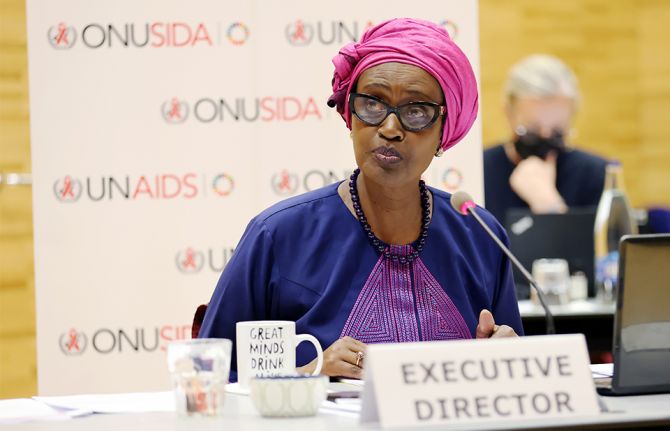
Press Release
UNAIDS Board closes after making bold decisions on societal enablers and ending HIV-related stigma and discrimination as a pivotal part of ending inequalities and AIDS
14 December 2021 14 December 2021GENEVA, 14 December 2021—The 49th meeting of the UNAIDS Programme Coordinating Board (PCB), which commenced on 7 December 2021, closed on 10 December.
In her opening remarks to the meeting, the UNAIDS Executive Director, Winnie Byanyima, thanked the Honourable Dr. Kalumbi Shangula, Minister of Health of Namibia for Namibia’s leadership as PCB chair and reflected on the foundations that have been laid over the course of the year for the future HIV response. These include the Global AIDS Strategy 2021–2026: End Inequalities, End AIDS and the new United Nations Political Declaration on AIDS and its related targets as well the UNAIDS Unified Budget Results and Accountability Framework 2022-2026. “This year, we put in place the foundations we need to end AIDS by 2030. The challenge now is to deliver on that plan,” Ms Byanyima said.
Ms Byanyima also spoke about the recent Structured Funding Dialogue convened to deepen the understanding of UNAIDS’ work and role in global health in the light of the significant shortfalls in funding that UNAIDS is experiencing.
Ms Byanyima, who began by paying tribute to the efforts of staff during this exceptionally challenging year, updated the Board on the process of implementing an organizational alignment of the UNAIDS Secretariat to ensure that it is modernized and efficient. “The new structure will bring us closer to countries and to the communities we serve, as well enable us to deliver on the strategy and help realize the transformational agenda needed to end AIDS by 2030,” she said, committing that the process would be implemented in a fair and transparent manner with support provided to staff who may be affected.
The effects of the COVID-19 pandemic on the HIV response were set out by the Executive Director. She noted that COVID-19 continues to disrupt HIV prevention and treatment services, schooling, violence prevention programmes and more, but that UNAIDS was supporting countries and partners to simplify and adapt HIV services in ways that both serve the needs of people living with HIV better and reduce unnecessary burdens on the health system.
Ms Byanyima spoke about the need to scale up access to pre-exposure prophylaxis and other HIV prevention options, which are key elements in the Global AIDS Strategy 2021–2026.
The PCB representative of the nongovernmental organization delegation addressed the Board on the key importance of scaling up work on societal enablers in the HIV response, noting the central role that communities must play to end AIDS as public health threat by 2030.
South African public health medicine specialist, Professor Salim Abdool Karim, addressed the PCB in the Leadership in the AIDS Response session. He stressed the need to scale up HIV treatment for people living with HIV and ensure that they have access to COVID-19 vaccination, since COVID-19 infections among people who are immunocompromised could lead to mutations of the SARS-CoV-2 virus. He also strongly argued against stigma and discrimination towards people living with HIV and against blaming them for SARS-CoV-2 mutations. He stressed the importance of community engagement to end inequalities and urged participants to stay focused on ending AIDS as a public health threat by 2030.
The PCB was given an update on HIV in prisons and other closed settings at which the Executive Director of the United Nations Office on Drugs and Crime, Ghada Fati Waly, spoke. The PCB called on countries to introduce and scale up evidence-based, gender-responsive and people-centred programmatic actions to ensure equal access for people in prisons and other closed settings to comprehensive and integrated HIV, tuberculosis and viral hepatitis prevention, diagnosis and treatment services.
Following on from the approval of the Unified Budget, Results and Accountability Framework (UBRAF) for 2022–2026 at a special session of the PCB in October 2021, the PCB received the outputs and indicators for the 2022–2026 UBRAF and a revised workplan for 2022–2023. Through the approval of the 2022-2023 workplan, the PCB provided the UNAIDS Joint Programme with a frame for scaling up its support to countries in implementing the Global AIDS Strategy 2021-2026. Many delegations stressed the importance of fully funding of the core UBRAF at US$ 210 million to be commensurate with the level of ambition of the Global AIDS Strategy, and some spoke to recent decisions of increased funding for the Joint Programme.
The progress on actions to reduce stigma and discrimination in all its forms, provides evidence that HIV-related stigma and discrimination remain among the major obstacles blocking the path to ending AIDS as a public health threat by 2030. Stigma and discrimination violate the rights and dignity of people living with or affected by HIV and result in denying them access to HIV prevention, testing and treatment services. Even in countries and regions showing strong progress towards ending their AIDS epidemics, stigma and discrimination continue to impede equitable progress. The PCB made bold calls to urgently end stigma and discrimination.
The PCB concluded with a thematic segment entitled What Does the Regional and Country-Level Data Tell Us, Are We Listening and How Can We Better Leverage that Data and Related Technology to Meet our 2020 and 2030 Goals? The segment explored how data, the bedrock of the progress against the AIDS pandemic over the past two decades, can be better collected and better used in the HIV response.
The meeting was chaired by Minister of Health of Namibia with Thailand serving as the Vice-Chair and the United States of America as Rapporteur. The report to the Board by the UNAIDS Executive Director, the reports for each agenda item and the PCB’s decisions can be found at www.unaids.org/en/whoweare/pcb/49.
UNAIDS
The Joint United Nations Programme on HIV/AIDS (UNAIDS) leads and inspires the world to achieve its shared vision of zero new HIV infections, zero discrimination and zero AIDS-related deaths. UNAIDS unites the efforts of 11 UN organizations—UNHCR, UNICEF, WFP, UNDP, UNFPA, UNODC, UN Women, ILO, UNESCO, WHO and the World Bank—and works closely with global and national partners towards ending the AIDS epidemic by 2030 as part of the Sustainable Development Goals. Learn more at unaids.org and connect with us on Facebook, Twitter, Instagram and YouTube.
Related information

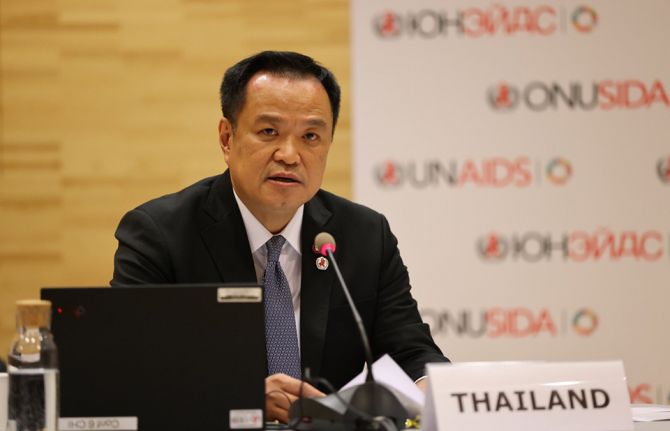
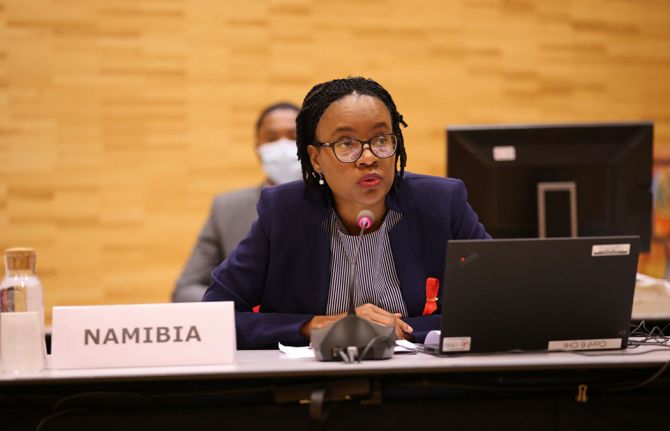
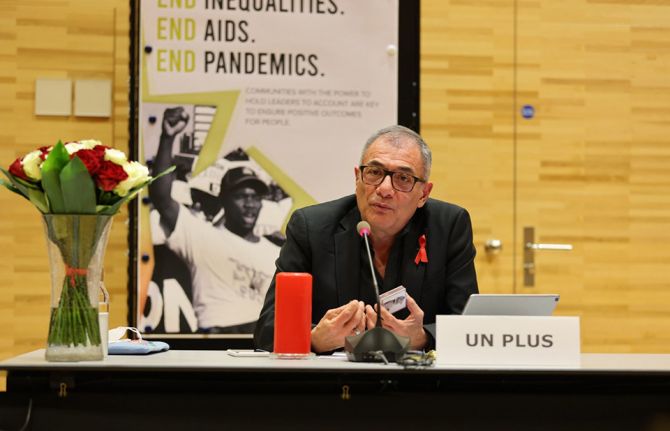
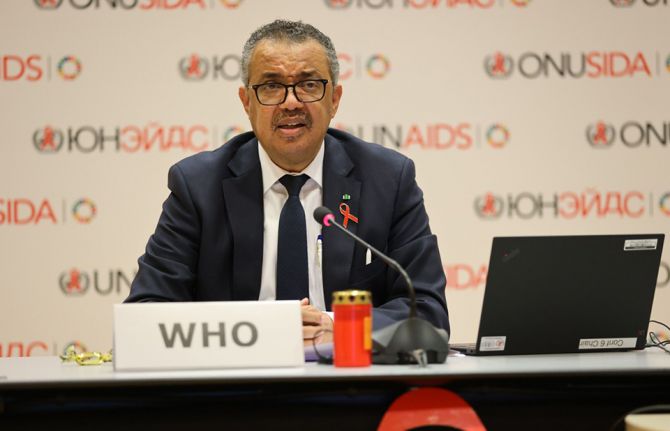
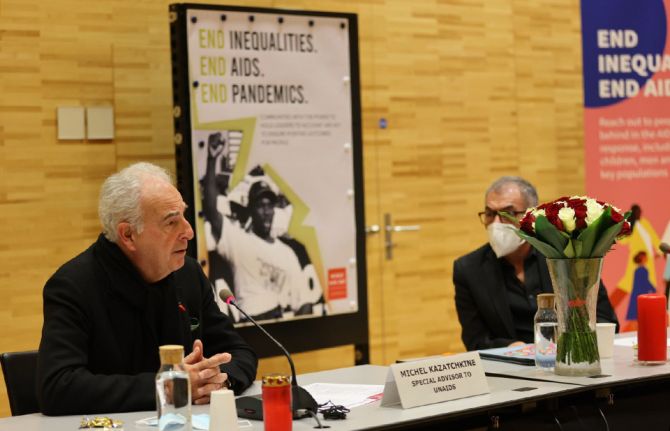
Press Release
World AIDS Day 2021—Step up, be bold, end AIDS, end inequalities and end pandemics
01 December 2021 01 December 2021With millions of lives on the line, UNAIDS and WHO World AIDS Day event saw global partners, including Prince Harry, the Duke of Sussex, urgently call for expanded access to health treatments and technologies and for human rights to be upheld
GENEVA, 1 December 2021—On the occasion of World AIDS Day 2021, UNAIDS, the World Health Organization (WHO) and partners came together at a special event in Geneva, Switzerland, to highlight the urgent need to end the economic, social, cultural and legal inequalities that drive the AIDS pandemic and other pandemics around the world.
“We are issuing an urgent warning. Only by moving fast to end the inequalities that drive the AIDS pandemic can we overcome it,” said Winnie Byanyima, Executive Director of UNAIDS. “World leaders must work together urgently to tackle the challenges head-on. I urge you: be courageous in matching words with deeds. It is outrageous that every minute that passes, we lose a precious life to AIDS. We don’t have time to waste.”
The world is off track from delivering on the shared commitment to end AIDS by 2030. In 2020 there were 37.7 million people living with HIV, 1.5 million new HIV infections and 680 000 AIDS-related deaths. Around 65% of HIV infections globally were among key populations, including sex workers and their clients, gay men and other men who have sex with men, people who inject drugs and transgender people, and their sexual partners.
“Even before the COVID-19 pandemic hit, many of the populations most at risk were not being reached with HIV testing, prevention and care services,” said Tedros Adhanom Ghebreyesus, WHO Director-General. “The pandemic has made things worse, with the disruption of essential health services, and the increased vulnerability of people with HIV to COVID-19. Like COVID-19, we have all the tools to end the AIDS epidemic, if we use them well. This World AIDS Day, we renew our call on all countries to use every tool in the toolbox to narrow inequalities, prevent HIV infections, save lives and end the AIDS epidemic.”
If the world does not tackle discrimination and inequalities, UNAIDS and WHO warn that the next decade could see 7.7 million AIDS-related deaths.
A powerful video narrated by Prince Harry, the Duke of Sussex, and Ms Byanyima was screened at the event demonstrating the disturbing parallels between access to HIV treatment and access to COVID-19 vaccines. Between 1997 and 2006, it is estimated that 12 million people died of AIDS-related illnesses in low- and middle-income countries as the price of medicines rendered them out of reach for many of the countries most affected by HIV. Today, 10 million people around the world still do not have access to the life-saving HIV medicines. The Duke of Sussex urged the world to learn from the history of AIDS and overcome the inequitable access to COVID-19 vaccines and to ensure that new HIV medicines and technologies are available to all.
A letter from the Duke of Sussex to WHO and UNAIDS was read out, in which he commemorated the 40 years of AIDS and expressed his gratitude for the work accomplished to date. In the letter he stressed the need for COVID-19 vaccine equity, drawing from the lessons learned from HIV.
Speakers highlighted the impact of HIV on young people. “Young people continue to be stigmatized, especially those in key populations, and inequalities continue to compromise the quality of our lives,” said Joyce Ouma, from the Global Network of Young People Living with HIV.
“Young people are the future of nations and the cornerstone of the global AIDS response,” said Anutin Charnvirakul, Deputy Prime Minister and Minister of Public Health, Thailand. “Eradicating all kinds of stigma must be our full global commitment with immediate action.”
During the event, the participants commemorated the lives of the 36 million people who have died from AIDS since the start of the pandemic and highlighted the urgent need to do more for the people most affected by HIV.
The Ambassador of Namibia, Julia Imene-Chanduru, representing the UNAIDS Programme Coordinating Board Chair, said, “AIDS remains an emergency that we must not forget in our response to COVID-19.”
Speakers urged all countries, partners and civil society to be bold in taking forward the commitment made in the Political Declaration on AIDS adopted at the 2021 United Nations High-Level Meeting on AIDS and in the Global AIDS Strategy 2021–2026: End Inequalities, End AIDS, both having ending inequalities at their core.
“We can see the importance of UNAIDS’ strategy, with an emphasis on ending inequalities,” said Stephanie Seydoux, French Ambassador for Global Health. “This is what allows us to make progress in the fight against this pandemic, and to ensure health for everyone.”
“We know how to beat AIDS and we know how to beat pandemics,” added Ms Byanyima. “The policies to address the inequalities standing in the way of progress can be implemented, but they require leaders to step up and be bold.”
UNAIDS
The Joint United Nations Programme on HIV/AIDS (UNAIDS) leads and inspires the world to achieve its shared vision of zero new HIV infections, zero discrimination and zero AIDS-related deaths. UNAIDS unites the efforts of 11 UN organizations—UNHCR, UNICEF, WFP, UNDP, UNFPA, UNODC, UN Women, ILO, UNESCO, WHO and the World Bank—and works closely with global and national partners towards ending the AIDS epidemic by 2030 as part of the Sustainable Development Goals. Learn more at unaids.org and connect with us on Facebook, Twitter, Instagram and YouTube.
Related links
Video


Press Release
UNAIDS warns of millions of AIDS-related deaths and continued devastation from pandemics if leaders don’t address inequalities
29 November 2021 29 November 2021GENEVA, 29 November 2021—UNAIDS issued a stark warning today that if leaders fail to tackle inequalities the world could face 7.7 million* AIDS-related deaths over the next 10 years. UNAIDS further warns that if the transformative measures needed to end AIDS are not taken, the world will also stay trapped in the COVID-19 crisis and remain dangerously unprepared for the pandemics to come.
“This is an urgent call to action,” said UNAIDS Executive Director Winnie Byanyima. “Progress against the AIDS pandemic, which was already off track, is now under even greater strain as the COVID-19 crisis continues to rage, disrupting HIV prevention and treatment services, schooling, violence-prevention programmes and more. We cannot be forced to choose between ending the AIDS pandemic today and preparing for the pandemics of tomorrow. The only successful approach will achieve both. As of now, we are not on track to achieve either.”
The warning comes in a new report by UNAIDS launched ahead of World AIDS Day (1 December) entitled Unequal, unprepared, under threat: why bold action against inequalities is needed to end AIDS, stop COVID-19 and prepare for future pandemics.
Some countries, including some with the highest rates of HIV, have made remarkable progress against AIDS, illustrating what is feasible. However, new HIV infections are not falling fast enough globally to stop the pandemic, with 1.5 million new HIV infections in 2020 and growing HIV infection rates in some countries. Infections are also following lines of inequality. Six in seven new HIV infections among adolescents in sub-Saharan Africa are occurring among adolescent girls. Gay men and other men who have sex with men, sex workers and people who use drugs face a 25–35 times greater risk of acquiring HIV worldwide.
COVID-19 is undercutting the AIDS response in many places. The pace of HIV testing declined almost uniformly and fewer people living with HIV initiated treatment in 2020 in 40 of 50 countries reporting to UNAIDS. HIV prevention services have been impacted—in 2020, harm reduction services for people who use drugs were disrupted in 65% of 130 countries surveyed.
“It is still possible to end the epidemic by 2030,” affirmed United Nations Secretary-General António Guterres in his World AIDS Day message. “But that will require stepped up action and greater solidarity. To beat AIDS—and build resilience against the pandemics of tomorrow—we need collective action.”
This new report from UNAIDS examines five critical elements of the plan agreed by Member States at the United Nations General Assembly High-Level Meeting on AIDS that must be urgently implemented to halt the AIDS pandemic and which are critical but under-funded and under-prioritized for pandemic prevention, preparedness and response. These include:
- Community-led and community-based infrastructure.
- Equitable access to medicines, vaccines and health technologies.
- Supporting workers on the pandemic front lines.
- Human rights at the centre of pandemic responses.
- People-centred data systems that highlight inequalities.
The call for upscaled investments and shifts in laws and policies to end the inequalities that drive AIDS and other pandemics is backed by leaders in global health and pandemic response from across the world.
“If we do not take the steps needed to tackle the inequalities driving HIV today, not only will we fail to end the AIDS pandemic, we will also leave our world dangerously unprepared for future pandemics,” said Helen Clark, Co-Chair of the Independent Panel for Pandemic Preparedness and Response, in a special foreword to the UNAIDS report. “Pandemics find space to grow in the fractures of divided societies. The amazing scientists, doctors, nurses and communities who work to end pandemics cannot succeed unless world leaders take the steps that will enable them to do so.”
UNAIDS and global health experts emphasize that while business as usual would kill millions and leave the world trapped with colliding pandemics going on for decades, leaders can, by acting boldly and together to tackle the inequalities in which pandemics thrive, end AIDS, overcome the COVID-19 crisis and be protected from the pandemic threats of the future.
“Pathogens ranging from HIV to the virus behind COVID-19 invade the cracks and fissures in our society with startling opportunism,” said Paul Farmer of Partners in Health, a nonprofit that for decades has effectively treated AIDS in settings of material poverty. “That the AIDS pandemic is shaped by deep structural inequalities need not resign us to inaction, however. Our teams, in rural Haiti and across the world, have routinely shown that with comprehensive care delivery, robust forms of accompaniment and social support and a larger dose of social justice, disparities in HIV outcomes can be rapidly narrowed, and health systems swiftly strengthened. We shouldn’t settle for anything less.”
This year marks 40 years since the first cases of AIDS were reported. Since that time, where investments have met ambition, there has been huge progress, particularly in expanding access to treatment. By June 2021, 28.2 million people had access to HIV treatment, up from 7.8 million in 2010, although progress has slowed considerably.
Countries with laws and policies aligned to evidence, strong community engagement and participation and robust and inclusive health systems have had the best outcomes, whereas the regions with the largest resource gaps and countries with punitive laws and that have not taken a rights-based approach to health have fared the worst.
“We know what works from seeing brilliant AIDS responses in some places,” said Ms Byanyima, “but we need to apply that everywhere for everyone. We have an effective strategy that leaders adopted this year, but it needs to be implemented in full. Ending inequalities to end AIDS is a political choice that requires bold policy reforms and requires money. We have reached a fork in the road. The choice for leaders to make is between bold action and half-measures.”
* The estimate of 7.7 million AIDS-related deaths between 2021 and 2030 is what UNAIDS models predict if HIV service coverage is held constant at 2019 levels. If the Global AIDS Strategy 2021–2026: End Inequalities, End AIDS is executed and the 2025 targets are achieved, UNAIDS estimates that at least 4.6 million of those deaths can be averted over the decade.
UNAIDS
The Joint United Nations Programme on HIV/AIDS (UNAIDS) leads and inspires the world to achieve its shared vision of zero new HIV infections, zero discrimination and zero AIDS-related deaths. UNAIDS unites the efforts of 11 UN organizations—UNHCR, UNICEF, WFP, UNDP, UNFPA, UNODC, UN Women, ILO, UNESCO, WHO and the World Bank—and works closely with global and national partners towards ending the AIDS epidemic by 2030 as part of the Sustainable Development Goals. Learn more at unaids.org and connect with us on Facebook, Twitter, Instagram and YouTube.

Press Release
UNAIDS calls for greater and sustained funding commitments to support its work in leading global efforts to end AIDS by 2030
19 November 2021 19 November 2021GENEVA, 19 November 2021—Having experienced major shortfalls in funding since 2015, UNAIDS convened donors, partners and Programme Coordinating Board members in Geneva, Switzerland, for a dialogue to help bolster UNAIDS’ efforts in supporting countries to end AIDS by 2030 as part of the Sustainable Development Goals.
During the meeting, held on 15 November 2021, UNAIDS warned that despite a growing number of countries demonstrating the feasibility of ending AIDS as a public health threat, the global HIV response is faltering, resulting in a slowing decline in new HIV infections and AIDS-related deaths. Around 1.5 million people became newly infected with HIV in 2020, and every 60 seconds someone died of an AIDS-related illness. Without an immediate course correction and renewed momentum, UNAIDS fears that hopes for reaching the 2030 target of ending AIDS could vanish.
“As we move into the next phase of the AIDS response, the risk of political neglect increases as the epidemic concentrates among the most marginalized, discriminated against and criminalized—key populations and adolescent girls and young women,” said Winnie Byanyima, Executive Director of UNAIDS. “The Joint Programme is needed now more than ever.”
The meeting was held to deepen the understanding of the work of UNAIDS and its critical role in global health. Speakers highlighted that since its inception in 1996, UNAIDS has brought unique value to the global AIDS response, leveraging the combined strengths of the United Nations system, leading efforts to expand access to HIV prevention, treatment and care services, increasing global resources for HIV, building political commitment and collecting data to build evidence-informed responses.
The Chair of the UNAIDS Programme Coordinating Board demonstrated how UNAIDS’ support has adapted to and been critical in the COVID-19 crisis. “In Namibia, we have seen very clearly the contribution of UNAIDS during this very difficult past year as we experienced an exponential increase in COVID-19 cases, hospitalizations and deaths,” said Julia Imene-Chanduru, representing the Chair of the UNAIDS Programme Coordinating Board. “Our health system was severely overstretched. During this time, UNAIDS supported Namibia to ensure the continuity of treatment for people living with HIV by supporting us to move to multimonth dispensing of antiretroviral treatment and assisting us in strengthening community engagement for COVID-19 and HIV.”
Speakers emphasized that UNAIDS has also been instrumental in tackling stigma and discrimination and fighting for equality and human rights. Overall, these unique, essential contributions from UNAIDS account for less than 1% of all funding available for HIV activities in low- and middle-income countries.
“Our health is a bedrock not only for life itself, but it is essential to achieving the Sustainable Development Goals,” said Amina Mohammed, Deputy Secretary-General of the United Nations. “UNAIDS is smart and brings transformative action to life. Of the total global funding for HIV, the 1% that UNAIDS represents helps leverage billions more. I urge you to continue to increase your contributions to this organization and support its incredible life-saving work.”
Since 2015, UNAIDS has experienced severe shortfalls in funding. For 2020 and 2021, UNAIDS had an approved annual budget of US$ 242 million. In 2020, UNAIDS raised US$ 194.1 million, but is expected to raise only US$ 165 million in 2021. The meeting provided an opportunity to deepen the understanding of donors of the work of UNAIDS and warned of the cost of inaction or insufficient funding.
“Our current funding situation limits what is possible and what can be made possible,” said Ms Byanyima. “It is time to invest. It is time to match our political ambition and equip all our stakeholders to drive the response forward and help realize the human right to health for all.”
“It is our responsibility as the Joint Programme to put AIDS back on the development agenda. But not only with the speeches but also with budgets. The call of the nongovernmental organization delegation is that we want a fully funded UBRAF. We want a fully funded UNAIDS and fully funded AIDS response,” said Gracia Violeta Ross Quiroga, National Chair of the Bolivian Network of People Living with HIV/AIDS (REDBOL).
UNAIDS urges donors and partners to create momentum around potential opportunities and mutual commitments relating to funding UNAIDS and the AIDS response, including prioritizing resource allocation and priority-setting. UNAIDS urges donors to ensure adequate, predictable and flexible funding for UNAIDS through multi-year agreements for core and non-core funding to fully support UNAIDS’ efforts to end AIDS by 2030.
“We reiterate calls that have been made today by the Secretariat and Cosponsors for funding to be predictable and sustained in order to enable the Joint Programme to deliver on our common goals. Kenya remains committed to supporting this process and stands ready to engage in any subsequent discussions,” said Peace Mutuma, Health Attaché, Permanent Mission of Kenya to the United Nations in Geneva.
UNAIDS
The Joint United Nations Programme on HIV/AIDS (UNAIDS) leads and inspires the world to achieve its shared vision of zero new HIV infections, zero discrimination and zero AIDS-related deaths. UNAIDS unites the efforts of 11 UN organizations—UNHCR, UNICEF, WFP, UNDP, UNFPA, UNODC, UN Women, ILO, UNESCO, WHO and the World Bank—and works closely with global and national partners towards ending the AIDS epidemic by 2030 as part of the Sustainable Development Goals. Learn more at unaids.org and connect with us on Facebook, Twitter, Instagram and YouTube.
Learn more
Video


Press Release
Botswana is first country with severe HIV epidemic to reach key milestone in the elimination of mother-to-child HIV transmission
02 December 2021 02 December 2021Brazzaville, Geneva, Nairobi, 2 December 2021 – Botswana has become the first high-burden country to be certified for achieving an important milestone on the path to eliminating mother-to-child transmission of HIV by the World Health Organization (WHO).
High-burden HIV countries are defined as those with more than 2% of pregnant women living with the virus. Botswana has achieved the “silver tier” status, which moves it closer to eliminating mother-to-child HIV transmission. WHO awards this certification to countries which have brought the mother-to-child HIV transmission rate to under 5 %; provided antenatal care and antiretroviral treatment to more than 90 % of pregnant women; and achieved an HIV case rate of fewer than 500 per 100,000 live births.
“This is a huge accomplishment for a country that has one of the most severe HIV epidemics in the world – Botswana demonstrates that an AIDS-free generation is possible,” said Dr Matshidiso Moeti, WHO Regional Director for Africa. “This groundbreaking milestone is a big step forward in ending AIDS on the continent and shows how visionary political leadership aligned with public health priorities can save lives. I look forward to other African countries also reaching this goal.”
Globally, 15 countries have been certified for eliminating mother-to-child HIV transmission. None of them had an epidemic as large as Botswana. The country’s feat to date on its journey to elimination is the result of a national response strategy spanning two decades. In 1999 and facing an HIV prevalence rate as high as 30%, Botswana initiated an aggressive programme to prevent mother-to-child transmission.
“Botswana’s pathfinding accomplishment demonstrates the remarkable progress that can be achieved when the needs of mothers living with HIV and their children are prioritized,” said Winnie Byanyima, UNAIDS Executive Director. “Children are among the groups left furthest behind in the HIV response. Addressing this inequality and preventing new HIV infections in children is critical if we are to end AIDS. Political commitment, strong leadership and the hard work of dedicated health care workers and communities in Botswana have delivered impressive results.”
Women living with HIV who do not receive antiretroviral (ARV) medicine have a 15–45% chance of transmitting the virus to their children during pregnancy, labour, delivery or breastfeeding. That risk drops to less than 5% if treatment is given to both mothers and children throughout the stages when transmission can occur. Botswana quickly achieved national ARV coverage before going on to implement increasingly effective regimens, following WHO guidance.
In 2013, Botswana became one of the first countries in the world to implement the so-called ‘Option B+’, a plan for treating all pregnant and breastfeeding women living with HIV with a highly effective lifelong triple antiretroviral treatment regimen at the time of diagnosis.
Mohamed Fall, UNICEF Regional Director for Eastern and Southern Africa, asserted that the country’s progress could serve as an example for others.
“We applaud Botswana for this remarkable achievement, which serves as inspiration to other countries in Eastern and Southern Africa,” said Mr Fall. “The progress on prevention of mother to child transmission of HIV in this region is truly a public health success, with more than 1.7 million new infections in children averted since 2010. We look forward to congratulating other countries very soon and continuing the journey to full and sustained elimination over time.”
The global validation criteria and processes date to 2015, when UNAIDS, UNICEF, WHO and other partners created the Global Validation Advisory Committee to standardize the measurement of achievements for eliminating mother-to-child transmission of HIV and syphilis. In 2017 and in recognition of the achievements made by countries with a high burden of HIV that were demonstrating significant and sustained reductions in the mother-to-child transmission rate, new Path to Elimination criteria were introduced. The elimination agenda has broadened to a “triple elimination” of mother-to-child transmission of HIV, syphilis and hepatitis B.
Botswana is now updating its guidance regarding syphilis and will expand its elimination objectives moving forward.
Please click the link below for audio-visual material: https://drive.google.com/drive/folders/1s9cONZBU2rkZtRZrpRGRXED2AJj5_3Yc?usp=sharing
UNICEF
UNICEF works in some of the world’s toughest places, to reach the world’s most disadvantaged children. Across 190 countries and territories, we work for every child, everywhere, to build a better world for everyone. For more information about UNICEF and its work for children, visit www.unicef.org. Follow UNICEF on Twitter and Facebook
WHO
The World Health Organization contributes to a better future for people everywhere. Good health lays the foundation for vibrant and productive communities, stronger economies, safer nations and a better world. As the lead health authority within the United Nations system, our work touches people’s lives around the world every day. In Africa, WHO serves 47 Member States and works with development partners to improve the health and well-being of all people living here. The WHO Regional Office for Africa is located in Brazzaville, Congo. Learn more at www.afro.who.int and follow us on Twitter, Facebook and YouTube.
UNAIDS
The Joint United Nations Programme on HIV/AIDS (UNAIDS) leads and inspires the world to achieve its shared vision of zero new HIV infections, zero discrimination and zero AIDS-related deaths. UNAIDS unites the efforts of 11 UN organizations—UNHCR, UNICEF, WFP, UNDP, UNFPA, UNODC, UN Women, ILO, UNESCO, WHO and the World Bank—and works closely with global and national partners towards ending the AIDS epidemic by 2030 as part of the Sustainable Development Goals. Learn more at unaids.org and connect with us on Facebook, Twitter, Instagram and YouTube.
Our work
Region/country

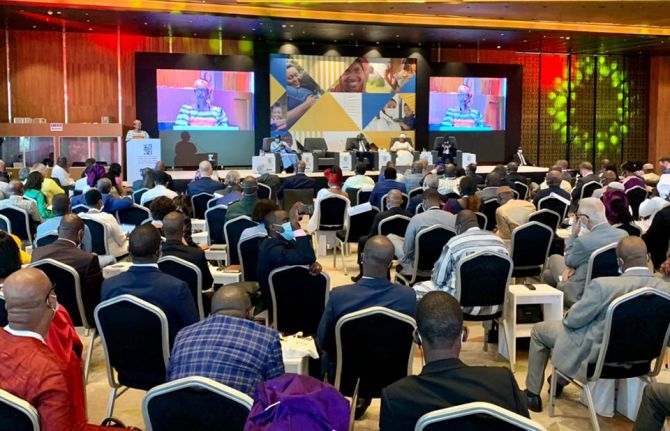
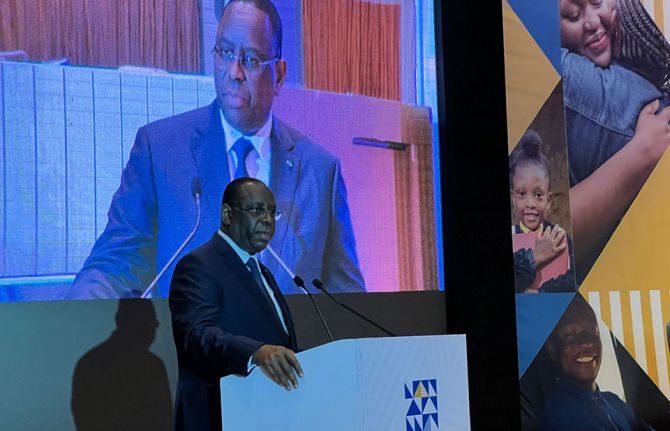
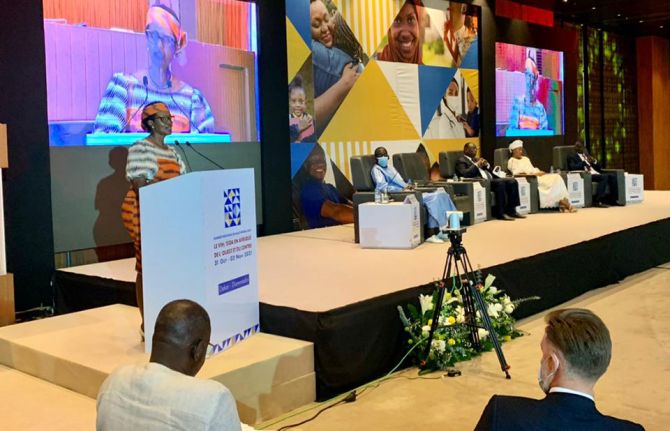
Press Release
Summit concludes with a call for action to reinvent the response to the HIV pandemic and end AIDS in Western and Central Africa
03 November 2021 03 November 2021The President of Senegal, Macky Sall, pledges an additional $3.5 million to support the HIV response and the call for action
DAKAR/GENEVA, 3 November 2021—A three-day regional summit on HIV/AIDS held in Dakar, Senegal, has concluded with a call to action that urges stronger support for community-led responses, policies driven by science and data, increased investment in the HIV response and putting HIV at the centre of pandemic preparedness and response. In his closing remarks, the President of Senegal, Macky Sall, committed to advancing the call to action with the African Union and pledged additional funds to implement it in Senegal and across the region.
Western and Central Africa is home to 4.7 million people living with HIV—12% of those living with HIV globally—but experiences 22% of all HIV deaths in the world. Countries in the region, on average, have seen slower declines in HIV infections than other countries on the continent and HIV prevalence in women is significantly higher than in men. Access to HIV testing and treatment reached 73% of people living with HIV in 2020, up from 38% in 2015, but short of the 81% goal that was set for 2020. The region has the world’s highest number of HIV-positive pregnant women still waiting for treatment, and just 24% of children living with HIV were virally suppressed.
The Dakar Call to Reinvent the Response to the HIV Pandemic calls for urgent action in four main areas:
1. Expand community-led infrastructure and organizations to strengthen national systems for health and shift policies to enable sustained funding for community organizations. Too many of the most vulnerable people in Western and Central Africa region do not have access to conventional health systems. Evidence shows community-led organizations and networks are critical to filling the gaps. This includes expanding the provision of HIV treatment and prevention services by community-led organizations in partnership with the public health system, ensuring that organized civil society and affected communities are included as key partners in decision-making bodies, and building accountability structures such as community-led monitoring.
2. Update health policies to align with the latest HIV science and evidence. Countries that have aligned their HIV policies and programmes with the current science have made greater progress against HIV/AIDS. Governments are urged to review their health policies in consideration of the latest scientific data and evidence. This is as a key step to improve the HIV response, and particularly to address the needs of those most vulnerable to HIV.
3. Increase national and international resources for HIV in the region by 33% by 2025 and remove financial barriers to access health services by people living with HIV. UNAIDS studies show that $2.67 billion by 2025, representing a 33% increase, would ensure sufficient funding for a comprehensive response to HIV in the region. Insufficient progress in the response to the HIV pandemic is only increasing the long-term costs that will strain already overburdened health budgets.
4. Put HIV and COVID-19 at the centre of pandemic preparedness and response. Many of the measures needed to accelerate the HIV response will also help prevent future pandemics. These measures include strengthening and protecting the formal and informal health workforce, collecting quality epidemic data to inform decision-making, implementing rights-based responses, and ensuring equitable access to new medical technologies.
These four actions are achievable in the next three years and would move the region closer to the 2025 global target of 95% of people knowing their HIV status; 95% of people who know their HIV status initiating treatment; 95% of people on treatment being virally suppressed. They would contribute to a dramatic reduction in the number of AIDS-related deaths and new HIV infections in the region.
Western and Central Africa has been at the forefront of some of the most innovative and successful efforts in the global response to HIV. Ending the AIDS epidemic as part of the 2030 Sustainable Development Agenda remains a priority even though the region faces multiple challenges including the response to the COVID-19 pandemic, numerous economic and security crises, and climate change.
During the summit governments, civil society actors, community-led organizations, scientists, and other partners reviewed new data and progress against HIV in the last 5 years and took note of the new UNAIDS Global AIDS Strategy 2021-2026 and the United Nations General Assembly Political Declaration on HIV and AIDS: Ending Inequalities and Getting on Track to End AIDS by 2030. The summit was co-organized by UNAIDS and the Civil Society Institute of HIV and Health in Western and Central Africa and hosted by the President of Senegal, Macky Sall. It was held with the support of Luxembourg and the Bill and Melinda Gates Foundation.
Quotes
“The key word today more than ever is mobilization. Let us mobilize for funding, for research and for vaccination. I am committed to working with you to advocate with the African Union and with partners to ensure that funding for the fight against HIV is strengthened and that this strengthening can begin with our African states themselves. I commit 2 billion CFA ($3.5 million) more in the fight against HIV, of which one billion will be given to the community fight by civil society and the other billion will go to the National AIDS Council to help people living with HIV.”
“Evidence shows the AIDS response is most effective when community-led organizations provide services as an integral part of the public response, are involved as co-planners, can highlight experiences and concerns, and play their essential role to ensure accountability. This conference issues a bold call to remove legal, policy and programmatic barriers that hold the region back from ending AIDS and to scale up resources to unleash the power of local organizations to help us end AIDS-related deaths and stop HIV infections.”
“This was an important development for West and Central Africa as the government of Senegal and UNAIDS co-hosted this high-level summit with civil society as equal partners-- showing what can happen when government, international stakeholders and civil society join together to respond to a pandemic.”
“If we want to achieve the SDGs, we need to increase public support for development. We need to strengthen systems that have suffered during the COVID-19 pandemic and make health systems more resilient.”
“We know that pandemics such as COVID-19, HIV and tuberculosis both exacerbate and thrive on inequalities—the world must take action to tackle inequalities and other barriers to health to end the HIV epidemic.”
“Paediatric care is weak in our region. Children born with HIV too often die from AIDS-related illnesses. We count on your leadership and political will so that children are no longer forgotten. For civil society, Dakar represents a new beginning.”
UNAIDS
The Joint United Nations Programme on HIV/AIDS (UNAIDS) leads and inspires the world to achieve its shared vision of zero new HIV infections, zero discrimination and zero AIDS-related deaths. UNAIDS unites the efforts of 11 UN organizations—UNHCR, UNICEF, WFP, UNDP, UNFPA, UNODC, UN Women, ILO, UNESCO, WHO and the World Bank—and works closely with global and national partners towards ending the AIDS epidemic by 2030 as part of the Sustainable Development Goals. Learn more at unaids.org and connect with us on Facebook, Twitter, Instagram and YouTube.
Contact
UNAIDSCharlotte Sector
tel. +41 79 500 8617
sectorc@unaids.org
UNAIDS
Tristan Gijsenbergh
tel. +221 77 480 3066
gijsenberght@unaids.org

Press Release
UNAIDS Board approves 2022–2023 budget and a five-year results and accountability framework
07 October 2021 07 October 2021GENEVA, 7 October 2021—The UNAIDS Programme Coordinating Board (PCB) has approved, at a special session, the Unified Budget, Results and Accountability Framework (UBRAF) for 2022–2026 and the UNAIDS budget for 2022 and 2023. The approved budget is set at up to a threshold of US$ 210 million per year.
“We must prevent a resurgent AIDS crisis. COVID-19 lockdowns and other restrictions have badly disrupted the use of HIV prevention services, access to HIV testing, and in many countries this led to steep drops in HIV diagnoses, referrals to care services, the initiation of HIV treatment and limitation in access to viral load testing. This is of great concern. That’s why approval of the UBRAF is so important,” said Winnie Byanyima, UNAIDS Executive Director, at the opening of the special session.
The UBRAF is the overall framework for the collective contribution of the UNAIDS Joint Programme to the global HIV response. It is the framework for leveraging the advantages, strengths and mandates of the 11 UNAIDS Cosponsors and the Secretariat for the full and effective implementation of the Global AIDS Strategy 2021–2026: End Inequalities, End AIDS, placing people and communities at the centre and in strong partnership with other stakeholders.
Under the new UBRAF, from 2022 to 2026 the Joint Programme will:
- Maximize its global leadership and advocacy.
- Create and promote the distribution of global public goods that are critical to ending AIDS.
- Support countries and communities through coordinated technical guidance and support.
- Facilitate and support strategic information and knowledge-sharing.
- Convene and facilitate multistakeholder dialogues to achieve enabling environments and leverage inclusive partnerships and investments to close programmatic and policy gaps for greater accountability, efficiencies and impact.
Areas of intensified focus and investment under the UBRAF are to:
- Tackle inequalities in order to ensure equitable access to services for HIV prevention, treatment, care and support.
- Foster leadership and support for innovative approaches to achieve more inclusive HIV services.
- Benefit from scaled-up HIV combination prevention and testing and treatment, with a focus on closing service gaps among those who are the furthest left behind.
- Champion the empowerment and resourcing of communities for stronger community-led responses that lead scaled-up service delivery and respond to needs.
- Strengthen societal enablers through more robust social, institutional and structural capacities of countries and communities for social protection, establishing and strengthening enabling legal environments, successfully eliminating stigma and discrimination and reaching gender equality in the HIV response.
- Advance the increased availability and financing of sustainable systems to achieve the 2025 HIV targets.
“Thank you for approving the framework and the budget. I took note and am encouraged by the clear requests and support by Board members for a fully funded UBRAF at US$ 210 million to help the Joint Programme deliver transformative and life-saving work towards the goals in the Global AIDS Strategy 2021–2026,” added Ms Byanyima at the session’s closing.
UNAIDS
The Joint United Nations Programme on HIV/AIDS (UNAIDS) leads and inspires the world to achieve its shared vision of zero new HIV infections, zero discrimination and zero AIDS-related deaths. UNAIDS unites the efforts of 11 UN organizations—UNHCR, UNICEF, WFP, UNDP, UNFPA, UNODC, UN Women, ILO, UNESCO, WHO and the World Bank—and works closely with global and national partners towards ending the AIDS epidemic by 2030 as part of the Sustainable Development Goals. Learn more at unaids.org and connect with us on Facebook, Twitter, Instagram and YouTube.
Special session, UNAIDS Programme Coordinating Board, 6 October 2021


Press Release
New report reveals stark inequalities in access to HIV prevention and treatment services for children—partners call for urgent action
21 July 2021 21 July 2021Almost half (46%) of the world’s 1.7 million children living with HIV were not on treatment in 2020 and 150 000 children were newly infected with HIV, four times more than the 2020 target of 40 000
GENEVA, 21 July 2021—In the final report from the Start Free, Stay Free, AIDS Free initiative, UNAIDS and partners* warn that progress towards ending AIDS among children, adolescents and young women has stalled and none of the targets for 2020 were met.
The report shows that the total number of children on treatment declined for the first time, despite the fact that nearly 800 000 children living with HIV are not currently on treatment. It also shows that opportunities to identify infants and young children living with HIV early are being missed—more than one third of children born to mothers living with HIV were not tested. If untreated, around 50% of children living with HIV die before they reach their second birthday.
“Over 20 years ago, initiatives for families and children to prevent vertical transmission and to eliminate children dying of AIDS truly kick-started what has now become our global AIDS response. This stemmed from an unprecedented activation of all partners, yet, despite early and dramatic progress, despite more tools and knowledge than ever before, children are falling way behind adults and way behind our goals,” said Shannon Hader, UNAIDS Deputy Executive Director, Programme. “The inequalities are striking—children are nearly 40% less likely than adults to be on life-saving treatment (54% of children versus 74% of adults), and account for a disproportionate number of deaths (just 5% of all people living with HIV are children, but children account for 15% of all AIDS-related deaths). This is about children’s right to health and healthy lives, their value in our societies. It’s time to reactivate on all fronts—we need the leadership, activism, and investments to do what’s right for kids.”
Start Free, Stay Free, AIDS Free is a five-year framework that began in 2015, following on from the hugely successful Global Plan towards the elimination of new HIV infections among children by 2015 and keeping their mothers alive. It called for a super Fast-Track approach to ensure that every child has an HIV-free beginning, that they stay HIV-free through adolescence and that every child and adolescent living with HIV has access to antiretroviral therapy. The approach intensified focus on 23 countries, 21 of which were in Africa, that accounted for 83% of the global number of pregnant women living with HIV, 80% of children living with HIV and 78% of young women aged 15–24 years newly infected with HIV.
“The HIV community has a long history of tackling unprecedented challenges, today we need that same energy and perseverance to address the needs of the most vulnerable—our children. African leaders have the power to help us change the pace of care and should act and lead until no child living with HIV is left behind,” said Ren Minghui, Assistant Director-General of the Universal Health Coverage/Communicable and Noncommunicable Diseases Division of the World Health Organization.
Although the 2020 targets were missed, the 21 focus countries in Africa made better progress than the non-focus countries. However, there were major disparities between countries, and these countries still bear the highest burden of disease: 11 countries account for nearly 70% of the “missing children”—those living with HIV but not on treatment. There was a 24% decline in new HIV infections among children from 2015 to 2020 in focus countries versus a 20% decline globally. Focus countries also achieved 89% treatment coverage for pregnant women living with HIV, compared to 85% globally, but still short of the target of 95%, and there were huge differences between countries. For example, Botswana achieved 100% treatment coverage, yet the Democratic Republic of the Congo only reached 39%.
“While we are deeply distressed by the global paediatric HIV shortfalls, we are also encouraged by the fact that we largely have the tools we need to change this,” said Angeli Achrekar, Acting United States Global AIDS Coordinator. “So, let this report be a call to action to challenge complacency and to work tirelessly to close the gap.”
The report outlines three actions necessary to end new HIV infections among children in the focus countries. First, reach pregnant women with testing and treatment as early as possible—66 000 new HIV infections occurred among children because their mothers did not receive treatment at all during pregnancy or breastfeeding. Second, ensure the continuity of treatment and viral suppression during pregnancy, breastfeeding and for life—38 000 children became newly infected with HIV because their mothers were not continued in care during pregnancy and breastfeeding. Third, prevent new HIV infections among women who are pregnant and breastfeeding—35 000 new infections among children occurred because a woman became newly infected with HIV during pregnancy or breastfeeding.
There has been some progress in preventing adolescent girls and young women from acquiring HIV. In the focus countries, the number of adolescent girls and young women acquiring HIV declined by 27% from 2015 to 2020. However, the number of adolescent girls and young women acquiring HIV in the 21 focus countries was 200 000, twice the global target for 2020 (100 000). In addition, COVID-19 and school closures are now disrupting many educational and sexual and reproductive health services for adolescent girls and young women, highlighting the urgent need to redouble HIV prevention efforts to reach young women and adolescent girls.
“The lives of the most vulnerable girls and young women hang in the balance, locked into deeply entrenched cycles of vulnerability and neglect that must urgently be interrupted. With the endorsement of United Nations Member States, the new global AIDS strategy recommits us all to address these intersecting vulnerabilities to halt and reverse the effects of HIV by 2030. We know that rapid gains can be achieved for girls and young women; what is needed is the courage to apply the solutions, and the discipline to implement these with rigor and scale,” said Chewe Luo, United Nations Children’s Fund Chief of HIV and Associate Director of Health Programmes.
UNAIDS and partners will continue to work together to develop new frameworks to address the unfinished agenda. New targets for 2025 were officially adopted by United Nations Member States in the 2021 Political Declaration on HIV and AIDS: Ending Inequalities and Getting on Track to End AIDS by 2030 in June this year, providing a road map for the next five years.
“It is clear that ending mother-to-child transmission requires innovative approaches that support the whole woman throughout the life course, including intensified primary prevention efforts, such as pre-exposure prophylaxis (PrEP), access to comprehensive reproductive care, and focused attention on adolescent girls and young women. The Start Free, Stay Free, AIDS Free report includes new the new targets for 2025 that, if met, will propel a new era of HIV prevention and treatment for women, children and families. This is not the time for complacency, but rather an opportunity to redouble investments to reduce and eliminate mother-to-child transmission,” said Chip Lyons, President and Chief Executive Officer of the Elizabeth Glaser Pediatric AIDS Foundation.
*The United States President’s Emergency Plan for AIDS Relief, UNAIDS, the United Nations Children’s Fund and the World Health Organization, with support from the Elizabeth Glaser Pediatric AIDS Foundation.
UNAIDS
The Joint United Nations Programme on HIV/AIDS (UNAIDS) leads and inspires the world to achieve its shared vision of zero new HIV infections, zero discrimination and zero AIDS-related deaths. UNAIDS unites the efforts of 11 UN organizations—UNHCR, UNICEF, WFP, UNDP, UNFPA, UNODC, UN Women, ILO, UNESCO, WHO and the World Bank—and works closely with global and national partners towards ending the AIDS epidemic by 2030 as part of the Sustainable Development Goals. Learn more at unaids.org and connect with us on Facebook, Twitter, Instagram and YouTube.
PEPFAR
PEPFAR is the largest commitment by any nation to address a single disease in history. Managed and overseen by the U.S. Department of State, and supported through the compassion and generosity of the American people, PEPFAR has saved 20 million lives, prevented millions of infections, and helped transform the global AIDS response.
UNICEF
UNICEF works in some of the world’s toughest places, to reach the world’s most disadvantaged children. Across more than 190 countries and territories, we work for every child, everywhere, to build a better world for everyone. Follow UNICEF on Twitter, Facebook, Instagram and YouTube
WHO
Dedicated to the well-being of all people and guided by science, the World Health Organization (WHO) leads and champions global efforts to give everyone, everywhere an equal chance at a safe and healthy life. We are the UN agency for heath that connects nations, partners and people on the front lines in 150+ locations – leading the world’s response to health emergencies, preventing disease, addressing the root causes of health issues and expanding access to medicines and health care. Our mission is to promote health, keep the world safe and serve the vulnerable. www.who.int
Elizabeth Glaser Pediatric AIDS Foundation
EGPAF is a proven leader in the fight for an AIDS-free generation and has reached over 31 million pregnant women with services to prevent transmission of HIV to their babies. Founded in 1988, EGPAF has supported over 15,000 sites and currently works in 17 countries to offer HIV counseling, prevention, diagnosis, and treatment services alongside high-quality family health care. Each stage of life—from infancy to adulthood—brings new and different challenges, and EGPAF is driven to see a world where no other mother, child, or family is devastated by this disease. For more information, visit www.pedaids.org.
Contact
UNAIDS GenevaSophie Barton-Knott
tel. +41 79 514 68 96
bartonknotts@unaids.org
WHO Geneva
Sonali Reddy
tel. +41795090747
reddys@who.int
Elizabeth Glaser Pediatric AIDS Foundation
Clare Dougherty
tel. +1 202.448.8483
cdougherty@pedaids.org
Press centre
Download the printable version (PDF)

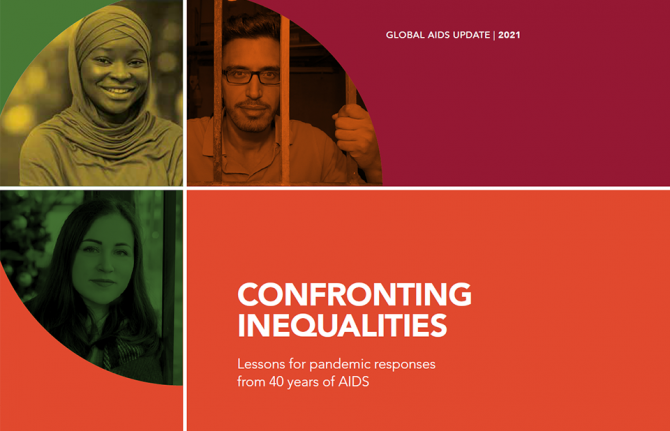
Press Release
UNAIDS report shows that people living with HIV face a double jeopardy, HIV and COVID-19, while key populations and children continue to be left behind in access to HIV services
14 July 2021 14 July 2021People living with HIV are at a higher risk of severe COVID-19 illness and death, yet the vast majority are denied access to COVID-19 vaccines. Key populations and their sexual partners account for 65% of new HIV infections but are largely left out of both HIV and COVID-19 responses—800 000 children living with HIV are not on the treatment they need to keep them alive
GENEVA, 14 July 2021—The UNAIDS Global AIDS Update 2021, launched today, highlights evidence that people living with HIV are more vulnerable to COVID-19, but that widening inequalities are preventing them from accessing COVID-19 vaccines and HIV services.
Studies from England and South Africa have found that the risk of dying from COVID-19 among people living with HIV was double that of the general population. In sub-Saharan Africa, which is home to two thirds (67%) of people living with HIV, less than 3% had received at least one dose of a COVID-19 vaccine by July 2021. At the same time, HIV prevention and treatment services are eluding key populations, as well as children and adolescents.
COVID-19 vaccines could save millions of lives in the developing world but are being kept out of reach as rich countries and corporations hold on tightly to the monopoly of production and delivery of supplies for profit. This is having a severe impact around the world as health systems in developing countries become overwhelmed, such as in Uganda, where football stadiums are being turned into makeshift hospitals.
“Rich countries in Europe are preparing to enjoy the summer as their populations have easy access to COVID-19 vaccines, while the global South is in crisis,” said Winnie Byanyima, Executive Director of UNAIDS. “We have failed to learn the lessons of HIV, when millions were denied life-saving medicines and died because of inequalities in access. This is totally unacceptable.”
The new UNAIDS report shows how COVID-19 lockdowns and other restrictions have badly disrupted HIV testing—in many countries this has led to steep drops in HIV diagnoses, referrals to care services and HIV treatment initiations. In KwaZulu-Natal, South Africa, for example, there was a 48% drop in HIV testing after the first national lockdown was imposed in April 2020. There were also fewer new HIV diagnoses and a marked drop in treatment initiation. This occurred as 28 000 HIV community health-care workers were shifted from HIV testing to COVID-19 symptom screening.
The report, Confronting inequalities, shows that in 2020 the 1.5 million new HIV infections were predominantly among key populations and their sexual partners. People who inject drugs, transgender women, sex workers and gay men and other men who have sex with men, and the sexual partners of these key populations, accounted for 65% of HIV infections globally in 2020. Key populations accounted for 93% of new HIV infections outside of sub-Saharan Africa, and 35% within sub-Saharan Africa. However, they remain marginalized and largely out of reach of HIV services in most countries.
The report shows that many of the 19 countries that achieved the 90–90–90 targets by 2020 have been leaders in differentiated service delivery, where facility-based services are complimented by community-led services. Most have also included key populations as central to their responses. In Estonia, for example, the expansion of comprehensive harm reduction services was followed by a 61% countrywide reduction in HIV infections and a 97% reduction in new HIV infections among people who inject drugs.
HIV testing and treatment has been scaled up massively over the past 20 years. Some 27.4 million of the 37.7 million people living with HIV were on treatment in 2020. However, gaps in service provision are much larger for children than for adults. In 2020, around 800 000 children aged 0–14 years who were living with HIV were not on HIV treatment. Treatment coverage was 74% for adults but just 54% for children in 2020. Many children were not tested for HIV at birth and remain unaware of their HIV status, making finding them and bringing them into care a major challenge.
Confronting inequalities also shows that women and girls in sub-Saharan Africa continue to be at a higher risk of HIV infection, with gender inequality and gender-based violence at the centre of that risk. Gender inequalities and gender-based violence rob women and girls of their fundamental human rights, including the right to education, health and economic opportunities. This increases their risk of HIV infection and blocks access to services. In sub-Saharan Africa, adolescent girls and young women account for 25% of all new HIV infections despite representing just 10% of the population.
Poverty and lack of schooling are also formidable barriers to health and HIV services. The report shows how family planning services for women and voluntary medical male circumcision for men and boys are much less likely to be accessed by people living in poverty. In 2020, the number of voluntary medical male circumcisions dropped by more than 30% in 15 priority countries in eastern and southern Africa.
Poverty is also a driver of migration, which has been shown to severely impact access to HIV services and puts lives in danger as migrants flee conflict and poverty in the hope of safety and economic security.
“Billionaires are sailing their yachts in the same Mediterranean waters that migrants are drowning in,” said Winnie Byanyima. “How can we stand by and let this be the “new normal”. We must confront these horrific inequalities and put the emphasis back on respect for basic, fundamental human rights.”
Inequalities are not naturally occurring. They are the result of policy and programmatic actions that divide rather than include. For example, key populations are marginalized and criminalized for their gender identities and expression, sexual orientation and livelihoods. New analysis included in the report shows a positive correlation between better HIV outcomes and the adoption of laws that advance non-discrimination. A study from sub-Saharan Africa found that HIV prevalence among sex workers was 39% in countries that criminalized sex work, compared to 12% in countries where sex work was partially legalized.
“We are 40 years into the fight against HIV. Both the successes and the failures have taught us that we cannot prepare for or defeat a pandemic unless we tear down inequalities, promote people-centred, rights-based approaches and work together with communities to reach everyone in need,” said Ms Byanyima.
UNAIDS
The Joint United Nations Programme on HIV/AIDS (UNAIDS) leads and inspires the world to achieve its shared vision of zero new HIV infections, zero discrimination and zero AIDS-related deaths. UNAIDS unites the efforts of 11 UN organizations—UNHCR, UNICEF, WFP, UNDP, UNFPA, UNODC, UN Women, ILO, UNESCO, WHO and the World Bank—and works closely with global and national partners towards ending the AIDS epidemic by 2030 as part of the Sustainable Development Goals. Learn more at unaids.org and connect with us on Facebook, Twitter, Instagram and YouTube.

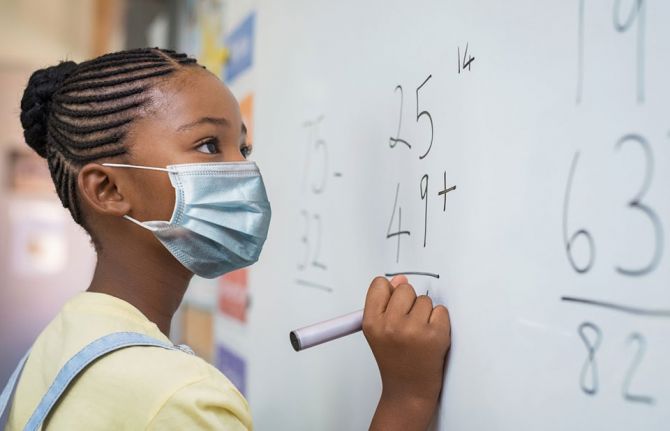
Press Release
Education Plus launched in response to alarming rates of HIV among adolescent girls and young women in Africa
06 July 2021 06 July 2021Unequal gender power dynamics continue to put women and girls at higher risk of acquiring HIV. Six out of seven new HIV infections among adolescents aged between 15 and 19 years in sub-Saharan Africa are among girls and 4200 adolescent girls and young women between 15 and 24 years became infected with HIV every week in 2020
GENEVA, 6 July 2021—Five United Nations organizations have joined forces to launch a new initiative to ensure that all girls and boys in sub-Saharan Africa have equal access to free secondary education by 2025 and to contribute towards preventing HIV. Education Plus, launched at the Generation Equality Forum in Paris, France, is an ambitious five-year high-level drive to accelerate action and investments to expand access to secondary education for all young people and to advance adolescent girls’ and young women’s health, education and rights in sub-Saharan Africa.
Before COVID-19 struck, around 34 million secondary school-aged girls in sub-Saharan Africa were being denied a full education and an estimated 24% of adolescent girls and young women (15–24 years) in the region were not in education, training or employed, compared to 14.6% of young men. One in four young people in sub-Saharan Africa aged 15–24 years are illiterate and the United Nations Children’s Fund (UNICEF) estimates that in 2020 school closures due to COVID-19 impacted around 250 million students in the region, millions of whom may never return to the classroom.
“We know that keeping girls in secondary school can reduce their risk of HIV infection by a third or more in places where HIV is common. It reduces their risk of child marriage, teenage pregnancy and gender-based and sexual violence and it can provide girls with the important skills and competencies for their economic empowerment,” said Winnie Byanyima, Executive Director of UNAIDS. “Bold and consistent political leadership is needed to ensure all children can complete a full round of secondary education in sub-Saharan Africa.”
The co-founders of Education Plus, UNAIDS, UN Women, the United Nations Educational, Scientific and Cultural Organization, the United Nations Population Fund and UNICEF, are urging countries to use education systems as an entry point to provide a holistic “plus” package of essential elements that adolescent girls and young women need as they become adults. These include comprehensive sexuality education, sexual and reproductive health and rights, including HIV prevention, freedom from gender-based violence and economic empowerment through school-to-work transitions.
Anita Myriam Emma Kouassi, a young activist from Benin, called on leaders to go beyond promises and act to end inequalities and gender discrimination against girls and young women in Africa. “Inequalities and illiteracy leave girls without the ability to take charge of their lives early on and without control over choices around their own bodies and health. We are thus left vulnerable without knowing how to defend ourselves or make our voices heard,” she said. “This is the reason why we cannot do without girls’ education; it is the bedrock and pillar of a strong nation with and for girls.”
To date, five countries—Benin, Cameroon, Gabon, Lesotho and Sierra Leone—have signed on to champion the initiative with a wide range of commitments that will tackle the urgency of effectively addressing the alarming numbers of adolescent girls and young women acquiring HIV and dying from AIDS-related illnesses, among other threats to their survival, well-being, human rights and freedoms, including sexual and gender-based violence and teenage pregnancy.
“Over the next three years, we will work to intensify awareness of sex education through training and the development of dedicated pedagogical material. We will support pregnant girls and young mothers in the case of early pregnancy. We will provide quality sanitary facilities and promote easy access to sanitary towels in schools,” pledged Rose Christiane Ossouka Raponda, the Prime Minister of Gabon. “The new Labour Code, which is currently before Parliament, will enrich our legal framework, particularly with regard to harassment in the workplace. Adolescent girls, young women and women as a whole will be even better protected to promote their social and professional development and their empowerment.”
Education has become an urgent concern amidst the COVID-19 pandemic and its socioeconomic impacts, which have increased girls’ and young women’s exposure to gender-based violence, child marriage and unintended pregnancies, increased the risks of maternal mortality and heightened vulnerabilities to acquiring HIV. Girls in sub-Saharan Africa are especially at risk of never returning to school.
David Moinina Sengeh, the Sierra Leone Minister of Basic and Senior Secondary Education, emphasized that countries must make decisions based on evidence and “Stop at nothing to make sure girls, including pregnant girls, are not left out of education,” adding that secondary education should include sexual and reproductive health in educational curricula. “People say it costs money, but it is going to be more expensive to us when we have high illiteracy in the future,” he argued. “It is already expensive to us when we have maternal mortality, it is already expensive to us when we have major parts of our adult population, women, excluded from the economy.”
The President of Sierra Leone, Julius Maada Bio, pledged that the country’s radical new inclusion policy would expand access to previously marginalized populations, including pregnant girls, parent learners, girls from poor backgrounds and those in hard-to-reach areas. “The governmental of Sierra Leone is committed to empowering adolescent girls, promoting and protecting their rights, accelerating progress on gender equality and social inclusion, reducing teenage pregnancy and new HIV infections.”
The initiative places emphasis on ensuring the meaningful participation and leadership of adolescent girls and young women in all their diversity, with attention to ensuring inclusiveness of those in especially excluded and vulnerable situations. Engaging men and boys with a focus on changing harmful gender norms and masculinities, and as allies and agents of change, is a cross-cutting aspect for Education Plus.
In presenting the Prime Minister of Lesotho’s Education Plus commitment, Dira Khama, the Permanent Secretary for Education, pledged that the country would expand secondary education, with a focus on rural areas, strengthen the implementation of comprehensive sexuality education, introduce vocational and technical streams to strengthen school-to-work transitions and work with parents and communities to reduce sexual and gender-based violence against adolescent girls and young women. The Prime Minister also committed, “To review and implement secondary school fees rationalization policy to reduce the amounts of school fees paid by individual households,” within the next six months to a year.
Education Plus will advocate for gender-responsive reforms in policies, laws and practices to guarantee the education, health and other social and economic rights of adolescents and young people. This includes changes in parental consent requirements and eliminating user fees for adolescents to access basic HIV and other sexual and reproductive health services, supporting pregnant adolescents and young mothers to complete their education and tackling gender-based violence, menstrual hygiene management and mental health, among others.
“It is important to look at HIV prevention systematically and not underestimate the special role of mental health when it comes to safe sex practices,” said Shudufhadzo Musida, Miss South Africa 2020. “In order to bring about mental health awareness, HIV prevention, economic empowerment and gender equality, we need to empower the minds of adolescent girls and young women now more than ever.”
Education Plus was launched as a joint commitment to the Generation Equality Forum. At the high-level virtual launch, Ms Byanyima was joined by Sierra Leone’s Minister of Basic and Senior Secondary Education, David Moinina Sengeh, the Tunisian diplomat and former African Union Youth Envoy, Aya Chebbi, a representative of the Education Plus Young Women’s leadership hub, Anita Myriam Emma Kouassi, and Miss South Africa 2020, Shudufhadzo Musida.
Delighted to launch the #EducationPlus initiative at today’s #GenerationEquality Forum - joint programme with @UNICEF, @UNFPA, @UN_Women, @UNESCO.
— Winnie Byanyima (@Winnie_Byanyima) July 1, 2021
We must ensure all girls in Africa and beyond can complete secondary education.
It’s time to #ActForEqual! https://t.co/5JE6axsPMC pic.twitter.com/myRdhKQF6E
UNAIDS
The Joint United Nations Programme on HIV/AIDS (UNAIDS) leads and inspires the world to achieve its shared vision of zero new HIV infections, zero discrimination and zero AIDS-related deaths. UNAIDS unites the efforts of 11 UN organizations—UNHCR, UNICEF, WFP, UNDP, UNFPA, UNODC, UN Women, ILO, UNESCO, WHO and the World Bank—and works closely with global and national partners towards ending the AIDS epidemic by 2030 as part of the Sustainable Development Goals. Learn more at unaids.org and connect with us on Facebook, Twitter, Instagram and YouTube.
